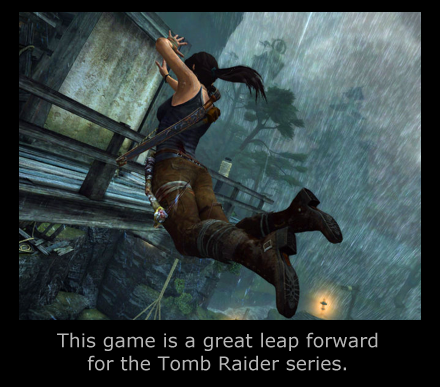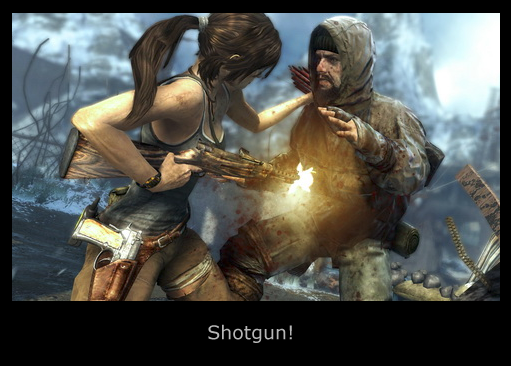 Tomb Raider is an excessively well known franchise possessing a total of 11 games, 2 movies, 3 novels, a series of comic books, a 10-Episode Animated series, and an amusement park ride (formally four). While more recent entries in the game series and overall franchise have been met with mixed critical reception, the first two games in the series are best remembered for pioneering the Action-Adventure genre. I, like many people, know of the series more through its pop-culture prevalence over active participation in the franchise.
Tomb Raider is an excessively well known franchise possessing a total of 11 games, 2 movies, 3 novels, a series of comic books, a 10-Episode Animated series, and an amusement park ride (formally four). While more recent entries in the game series and overall franchise have been met with mixed critical reception, the first two games in the series are best remembered for pioneering the Action-Adventure genre. I, like many people, know of the series more through its pop-culture prevalence over active participation in the franchise.
Now, that’s not to say that I haven’t played any Tomb Raider games. In addition to a handful of demos, I vaguely remember playing one of the original Core Design-developed titles and one of the lesser Crystal Dynamics-developed games. The fact that the Crystal Dynamics demo and game that I played had rather unfriendly controls and were overall mediocre is rather disappointing. I personally love the Action-Adventure genre and would probably rate it as my favorite overall, and I find the ideas of both the games’ Indiana Jones-esque setting and strong female protagonist very appealing.
Due to this I was quite interested, despite some of Crystal Dynamics’ previous work, in their upcoming re-imagining of the Tomb Raider series. All the way up to the March 5th, 2013 release date I followed information on the games’ development and even got to try a demo of the game at New York Comic Con 2012. Having been impressed with the demo and the apparent amount of work that the Crystal Dynamics’ development team was putting into the game, I acquired it upon release.
GAMEPLAY
The first thing I want to address in my review is glitches. For point of reference, I played the Playstation 3 version of the game and, generally speaking, amongst my friends I am most likely to encounter zany glitches. I have heard tales on the internet of many people running into game-breaking and otherwise severe glitches. In the case of PCs, I’ve heard this is a driver-based issue with the shiny new tech the PC version uses to render Lara’s hair and that turning off said feature (and turning down graphic settings) will in most cases remedy the more severe render issues. With that out of the way, I amazingly confronted only three glitches in my entire playthrough– none of which were game breaking. At no point did my game crash or cause a system freeze/lock-up, which I consider to be somewhat astounding considering both my Playstation 3 (especially when playing Skyrim) and 360 (especially during long play sessions) have a noted tendency to freeze on me.
As for the glitches I did encounter, the first appeared to be a simple collision detection error between Lara and a cliff-face while traversing a rope. The second glitch– which is the only one that killed me– I suspect may have also been a collision detection error. However, this one involved Lara landing, and instead of standing upon the ground, she kind of bounced off the ground and a nearby wall flinging her over the side of a cliff and to her death. Honestly though, with the checkpoint system and autosaves, that glitch was much more humorous than it was harmful to my play session. The last glitch I encountered had Lara stuck in “combat mode” (with her gun drawn) and a single chord of music being constantly replayed which persisted even after moving to the entire other end of the map. This final glitch was the only one that required any form of reset and consisted only of returning to the main menu and reloading the save. So, I don’t know personally what people are talking about when they speak at-length of all these “horrible” glitches in this game.
As for the intended gameplay, Tomb Raider is a very solid Action-Adventure game. The focus of the gameplay seems to be more on platforming/traversing the environment and mild puzzle solving over combat. Which is exactly how I think the Tomb Raider series should be balanced. In fact, I think the game could’ve done with a little less combat in certain parts. Many have taken to comparing the games’ basic field to the Uncharted series and the Alan Wake game– neither of which I have played much.
The exploration/platforming portion of the gameplay is perhaps the best it has been in the series. In particular, the landing of jumps and ledge-grabs feel especially sound. At no point in my playthrough did I feel like a missed jump was due to a failing of the games’ control or level design. In addition to the basic platforming, traversing your environment requires several tools you pick-up along the way, most notably a climbing axe and a rope arrow. These elements help to add variety to the way you move about the game’s setting (an island) as well as serving double-duty as tools to overcome obstacles.
On the combat side of things, the game fares equally well. I kind of want to complain about the game’s combat because it can be quite frantic and occasionally, surprisingly difficult. However, I can’t really fault the game for either of these things since they’re actually quite realistic and pay tribute to well-programmed AI. At one point in particular, I had a hard time with enemies circling around behind me from what I thought was a choke point. Most of the time, ranged enemy units will get behind any available cover and attempt, not only to pin you down, but also advance on your position. Melee enemies, on the otherhand, will attempt to rush you and kill you before you can kill them. Most AI also exhibit some awareness of their surroundings and communication. If one comes across a fallen comrade, he will alert all other enemies in the area that there is an intruder present. Also, triggering sound traps or being spotted by an enemy will cause an entire area to be aware of your presence.
In terms of your personal arsenal, I don’t think it’ll surprise anyone to learn that Lara is eventually equipped with more than just a bow and arrow. The various guns she acquires and modifies throughout the game are quite fun. In terms of your available arsenal, the guns tend to provide an almost frustratingly prevalent recoil which combined with their excessive audibility means that there is always a place for your bow and arrow. This also leads to a rather superior feel to combat, much like the platforming, even when something appears difficult, it doesn’t feel wrong. In terms of the modifications for your weapons, some focus more on base utility such as increased ammo size and reduced recoil while others focus on fun extra capabilities such as napalm arrows. Some of these modifications feel a little more pointless than others, but I would say all, or at least most of them, have their place.
Speaking of modifications, they and a number of skills Lara learns through her adventure are acquired via an experience system. This appears somewhat RPG-heavy in the beginning when most of the more potent skills are locked behind higher tiers. Luckily, there are only a few tiers which are unlocked by purchasing available skills. This means that while it may appear somewhat overwhelming at first, you will quickly find yourself plowing through them at a fair pace (Especially if you partake in some of the additional/collectible objectives). Much like the modifications, some of the skills are rather mundane such as an increase to your durability/health and the amount of experience/salvage you gain from certain things while others offer entirely new abilities such as being able to counter enemies and revealing the location of close collectibles on your map.
The game takes place entirely on an island broken up into multiple zones. These zones appear to come in three types: Fairly straight-forward linear paths, larger, more open explorable areas, and scripted event zones. The first two types are rife with collectibles and possess camps, which serve as hubs– allowing you to upgrade skills and equipment as well as, in the case of Base Camps, fast-travel between them. These areas contain the bulk of your standard Action-Adventure gameplay full of platforming/exploration and groups of enemies. The last type of zone is rather different, the focus not being as much on taking out enemies or exploring, but rather escaping/traveling long distances (such as being dragged down a river current or being chased by a crashing plane). These zones also lack collectibles or the ability to return to them later.










Comments (0)